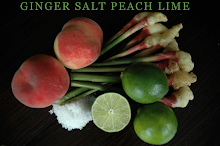
A funny thing happened at the izakaya last week. Four of us were having a late dinner, an assortment of fried goodness -- oysters, chicken, pizza (it had a tasty fried potato hash on top), mochi wrapped with cheese and bacon. One of us, not me I'm afraid, had the good sense to order some miso-shiru for a little warmth and nutrition on the table.
"What is miso anyway?" the soup sipper asked.
My friend and I answered at the same time. Ground soy beans, I said. Fermented rice, she said. We both looked at each other, perplexed. "But fermented beans are natto," my friend logically replied. She had a point. Fermented soy beans are natto, a sour, stringy blob with an unfortunate smell that is a staple in Japan but that few westerners, including me, can eat. And my friend, I should mention, is Japanese. Who was I to argue?
But rice in miso? Every American recipe I'd ever read said miso was fermented bean paste. I've been trying to hard to learn about Japanese food. I mean, I'd even try natto again. Really. Just to be sure it's one of the most unpleasant tastes in the world. So how could I be wrong about miso?
So this is what it comes to. Here I am, an American who speaks no Japanese arguing with a Japanese woman about a building block of her own cuisine. I could feel my visa crumpling. In my own defense I had had a margarita and two beers before our 10 o'clock dinner. In her own defense, she decided we should wait a day and ask another friend's advice to break the stalemate.
We forgot about the great miso debate the next day, so it wasn't until this morning I decided to consult Shizuo Tsuji. His entry on page 76 reads: Miso, fermented bean paste. Ha! But the entry goes on for a page and half. Turns out miso starts with crushed boiled soy beans, but it needs wheat, barley or rice to work with the active ingredient to make the fermentation work. The variety of ingredients and the length of maturity accounts for the variety of flavors. Light or yellow miso includes rice, which makes it sweet and good for dressings. Red miso, the most common kind in America, uses barley. Some miso pastes are allowed to age for three years, some chunky, some smooth. Certain kinds can be salty, but I've found the types I've tried in Japan are much less salty than the tubs I bought in America. It makes me think the salty stereotype of Japan's soy products are really another bastardization of a wonderfully healthy food.
And miso is nothing if not healthy -- protein, iron and non-sat fat, the good kind. It gives tang and depth to marinades and dressings. I've taken to using a small spoonful to clear-broth soups that taste a little tired, much like you would with tomato paste. Yes, it has some salt. But if you put it on plain fish or mix it with vinegar and oil for a quick salad dressing, I say no harm, no foul. It's certainly healthier than eating fried potatoes on top of a pizza. We all have choices to make.
Last weekend in Nagano, I picked up a small jar of Nagano miso, one made with ingredients from the mountains that is supposed to give a stronger, sharper taste. Of course, I know now in theory what sits in the jar. But I'll have to have my friend help me with the kanji to decipher the exact ingredients. A little mystery and discovery never hurt anyone.


No comments:
Post a Comment